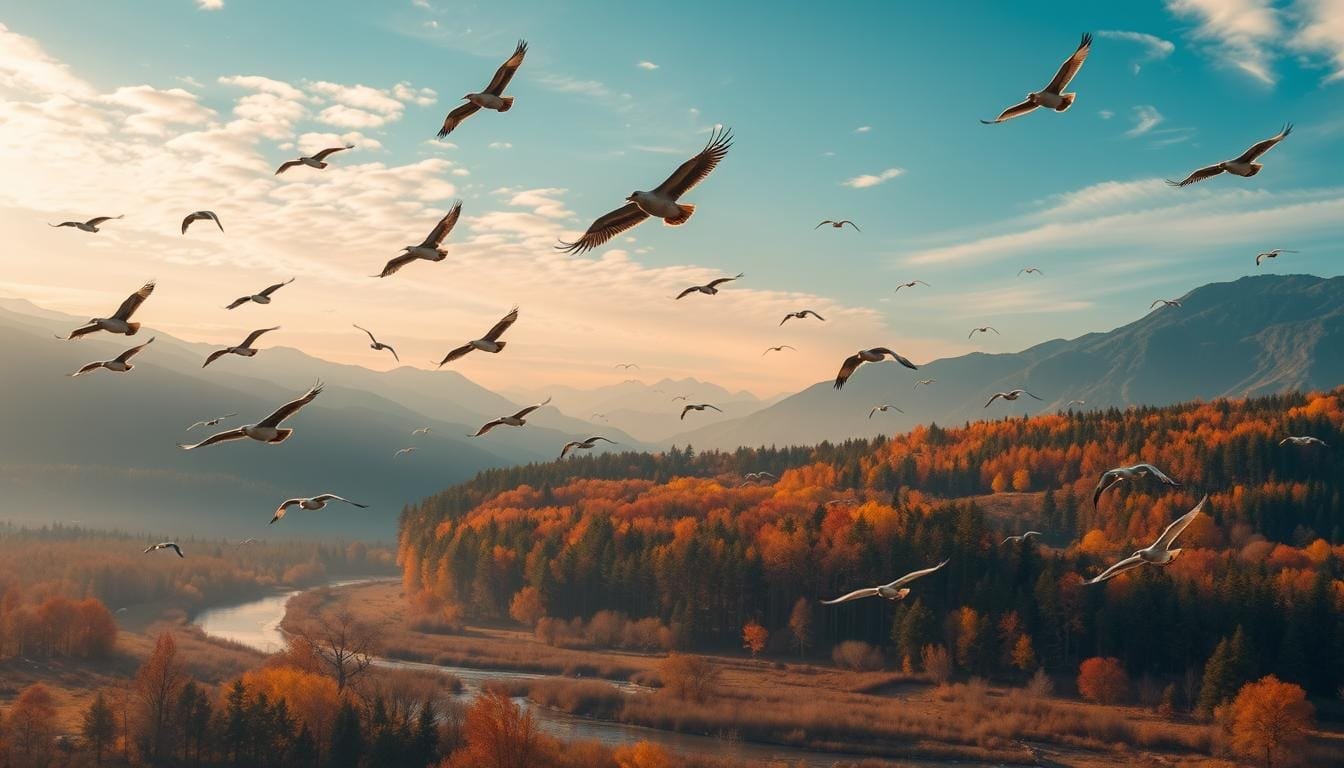The USA is full of migratory animals. They show the amazing variety of wildlife in North America. These creatures travel long distances, following old paths in the US and more.
Seasonal animal movements keep ecosystems in balance across the country. The U.S. Fish and Wildlife Service works hard to protect migratory birds. They focus on big efforts across flyways and continents.
Did you know over 500 bird species live in Arizona? Half of them migrate. Places like Saguaro National Park are key for birds like red-faced warblers and painted redstarts.
Bird watching brings in millions to Arizona’s economy. People come from everywhere to see these birds. It’s a big help to the local economy.
Let’s learn more about migratory animals in the USA. We’ll look at their amazing journeys, the challenges they face, and how we help them. Join us to discover the secrets of North America’s bravest travelers!
Understanding USA Migratory Animals and Their Seasonal Patterns

Migratory animals are key to American ecosystems. They include butterflies and animals that move with the seasons. These journeys shape our natural world.
The Role of Migration in American Ecosystems
Migration keeps ecosystems balanced. It spreads nutrients and supports many species. For example, salmon runs bring ocean nutrients to rivers, helping both water and land.
Factors Driving Animal Migration in North America
Many things influence animal migration in North America:
- Food availability
- Breeding grounds
- Climate conditions
- Seasonal changes
Birds migrate south for winter to find food and warmth. Monarch butterflies travel up to 3,000 miles to Mexico for the winter.
Impact of Climate Change on Migration Routes
Climate change is changing migration routes and times. Warming waters are causing some sharks to stop migrating. This change affects entire ecosystems.
The U.S. Fish and Wildlife Service is working to save habitats. They aim to keep animal populations healthy.
It’s important to understand these patterns and challenges. By studying bird and animal migrations, we can protect these natural processes. This helps us face environmental changes.
Major Bird and Insect Migrations Across America
The United States sees amazing migrations every year. Birds and insects travel long distances. These journeys show us nature’s beauty and why we must protect their homes.
Arctic Tern’s Remarkable Journey
Arctic terns migrate the farthest. They fly 55,923 miles each year. They go from the Arctic to the Antarctic, crossing huge oceans.
Monarch Butterfly Migration Pathways
Monarch butterflies migrate up to 3,000 miles. They fly from Canada to Mexico. Some travel 265 miles in one day, using the sun and Earth’s magnetic field to guide them.
Migratory Waterfowl and Songbirds
Many birds migrate in different ways. Some go to South America, while others stay in the southeastern U.S. Over 500,000 sandhill cranes gather in Nebraska’s Platte River. These patterns show how complex bird migrations are.
Dragonfly Migration Patterns
Dragonflies migrate an incredible 14,000 to 18,000 kilometers. They travel for four generations. They follow rain patterns, showing how connected nature is. Their journey is a testament to their strength and ability to adapt.
| Species | Migration Distance | Notable Facts |
|---|---|---|
| Arctic Tern | 55,923 miles | Longest bird migration in the world |
| Monarch Butterfly | Up to 3,000 miles | Can fly 265 miles in a single day |
| Sandhill Crane | Varies | 500,000+ gather at Platte River, Nebraska |
| Dragonfly | 14,000-18,000 kilometers | Four-generation migration journey |
Marine and Land-Based Migration Routes in the United States
The United States is home to amazing animal migrations. These journeys show nature’s strength and why we must protect it.
Grey Whale Migration Along Pacific Coast
Grey whales travel 10,000 to 14,000 miles round trip along the US Pacific coast. It’s one of the longest mammal migrations. They go from Alaska to Baja California, Mexico, for breeding and birth.
Salmon Runs in American Rivers
Salmon runs show nature’s never-give-up spirit. These fish swim hundreds of miles in freshwater and up to 1,000 miles in the ocean. They use the Earth’s magnetic field and smell to find their way back to spawn. But, many salmon face dangers from lost habitats and climate change.
Caribou Herds in Alaska
In Alaska’s vast wilderness, caribou herds migrate up to 838 miles each year. They move between winter and summer grounds, facing many challenges. Their journey is key for the Arctic and the people who live there.
Sea Turtle Navigation Paths
Sea turtles, like leatherbacks and loggerheads, travel huge distances across the Pacific. Some go over 22,000 miles in two years. They use special skills to cross the vast ocean. Saving their paths is vital, as they face dangers from pollution and lost habitats.



